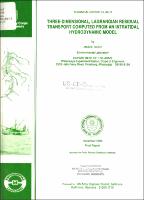Please use this identifier to cite or link to this item:
https://hdl.handle.net/11681/32844Full metadata record
| DC Field | Value | Language |
|---|---|---|
| dc.contributor.author | Dortch, Mark S. | - |
| dc.date.accessioned | 2019-05-31T15:33:27Z | - |
| dc.date.available | 2019-05-31T15:33:27Z | - |
| dc.date.issued | 1991-11 | - |
| dc.identifier.govdoc | Technical Report EL-90-11 | - |
| dc.identifier.uri | https://hdl.handle.net/11681/32844 | - |
| dc.description | Technical Report | - |
| dc.description.abstract | A procedure was developed for computing three-dimensional, Lagrangian residual circulation from an intratidal (i.e. contains tidal fluctuations) hydrodynamic model for driving an intertidal (i.e. tidal fluctuations are removed) transport model. A three-dimensional, finite difference, hydrodynamic model, CH3D, which uses boundary-fitted coordinates in planform and vertical cartesian coordinates, was indirectly coupled to a water quality transport model that uses an integrated compartment solution. The coupling of the two models was accomplished through the development of an interface processor implemented within the hydrodynamic model. The processor converts nondimensional, contravariant velocities in transformed coordinates to dimensional, physical flows for the transport model. The sum of Eulerian residual velocities and Stokes' drift was used as a first-order approximation for the Lagrangian residual currents. The Stokes' drift approximates residual currents induced by the nonlinear interactions of the tidal currents and represents the net drift experienced by a particle passing through a spatially varying velocity field in an oscillating flow. A Stokes' drift formulation that guarantees mass conservation was implemented within the interface processor so that intertidal (i.e. tidally averaged) hydrodynamic information could be processed and output as the intratidal hydrodynamic model is executing. This information is subsequently used to drive intertidal mass transport. Computed residual velocities were compared against a two-dimensional (vertical-longitudinal) analytical result to ensure proper implementation. Other than some adjustment of eddy viscosity to account for the effects of numerical dampening, the computed residual currents compared favorably with the analytical result. The methodology was evaluated through an application to Chesapeake Bay. Salinity computed by the two models and observed data were compared for the entire year 1985. Salinity computed with the intertidal transport model (i.e. with Lagrangian residuals) showed good agreement with observed salinity and that computed with intratidal transport. The developed procedures provide a practical means of making long-term, three-dimensional transport computations for weakly nonlinear tidal systems. Use of processed intertidal hydrodynamics reduces computer disk space requirements by 10-fold compared with intratidal hydrodynamics. Substantial savings in computation time for long-term transport computations can also be realized. | en_US |
| dc.description.sponsorship | United States. Army. Corps of Engineers. Baltimore District. | en_US |
| dc.format.extent | 281 pages / 9.317 Mb | - |
| dc.format.medium | PDF/A | - |
| dc.language.iso | en_US | en_US |
| dc.publisher | Environmental Laboratory (U.S.) | en_US |
| dc.publisher | U.S. Army Engineer Waterways Experiment Station. | - |
| dc.relation.ispartofseries | Technical Report (U.S. Army Engineer Waterways Experiment Station.) ; no. Technical Report EL-90-11 | - |
| dc.rights | Approved for Public Release; Distribution is Unlimited | - |
| dc.source | This Digital Resource was created in Microsoft Word and Adobe Acrobat | - |
| dc.subject | Harbors--Hydrodynamics--Mathematical models | en_US |
| dc.subject | Water quality--Mathematical models | en_US |
| dc.subject | Lagrangian functions | en_US |
| dc.title | Three-dimensional, Lagrangian residual transport computed from an intratidal hydrodynamic model | en_US |
| dc.type | Report | en_US |
| Appears in Collections: | Technical Report | |
Files in This Item:
| File | Description | Size | Format | |
|---|---|---|---|---|
| Technical Report EL-90-11.pdf | 9.54 MB | Adobe PDF |  View/Open |